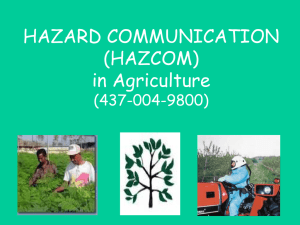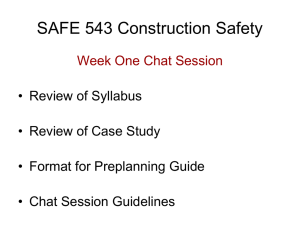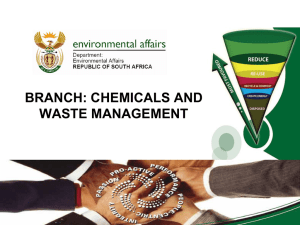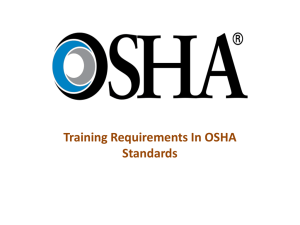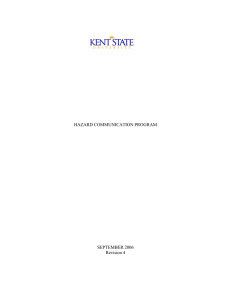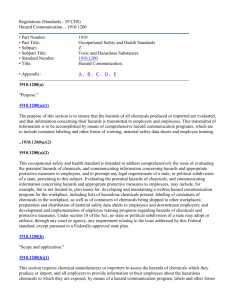Hazard Communication Standard 29 CFR 1910.1200
advertisement
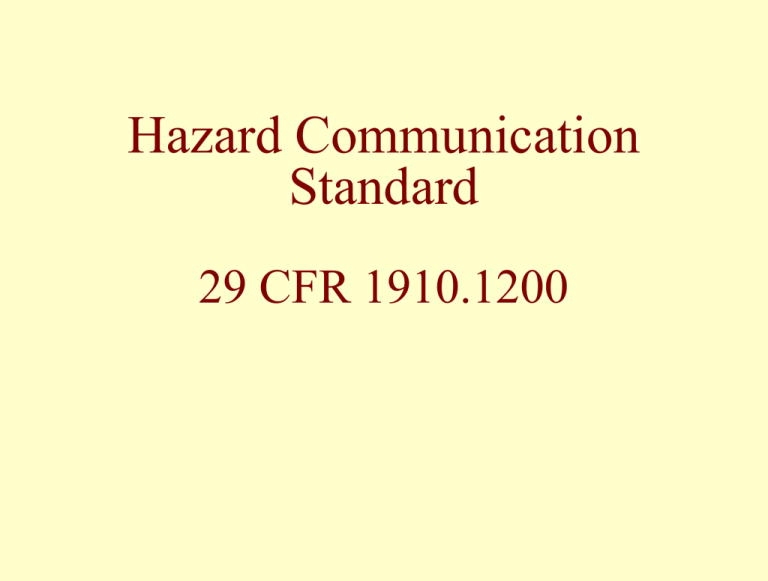
Hazard Communication Standard 29 CFR 1910.1200 Hazard Communication Standard • To ensure physical and health hazards are evaluated • (all chemicals produced in or imported into USA) • To ensure hazard information is shared with employers and employees • To provide a national law to communicate chemical hazards that preempts state and local laws 29 CFR 1910.1200 (a) (1) Hazard Communication Standard Coverage of HCS - Who Has Responsibilities? • Chemical Manufactures – Evaluate hazards of chemicals – Provide labels / MSDSs to employers that they ship chemicals to • Importers and Distributors – Provide labels / MSDSs to employers that they ship chemicals to 29 CFR 1910.1200 (b) (1) • Employers that “Use” Chemicals – Inventory hazardous chemicals – Prepare and implement written program – Ensure that all in-plant containers are properly labeled – Ensure all MSDSs are obtained for all hazardous chemicals – Train employees * “Use” means to package, handle, react, or transfer. 29 CFR 1910.1200 (b) (1) Hazard Communication Standard Coverage of HCS - Chemicals that are Hazards • Physical Hazard - Any chemical that is: – – – – – – – – – A combustible liquid A compressed gas Explosive Flammable An organic peroxide An oxidizer Pyrophoric Unstable (reactive) Water-reactive 29 CFR 1910.1200 (c) (definitions) • Health Hazard - Any chemical that may produce acute or chronic health effects in exposed employee – Carcinogens – Toxic or highly toxic agents – Reproductive toxins – Irritants – Corrosives – Sensitizers – Hepatotoxins – Nephrotoxins – Neurotoxins – Agents which act on the hematopoietic system – Agents which damage the lungs, skin, eyes, or mucous membranes 29 CFR 1910.1200 (c) (definitions) Hazard Communication Standard Written Hazard Communication Program • Reflects what you are doing in your workplace generic plans must be adapted to specific conditions at you facility • Includes all the following: 1. The hazardous chemicals present at the site 2. Who is responsible for the various parts of the program 3. Where the MSDS’s will be available to employees 4. How your facility will meet the requirements for * Levels and other forms of warning * Material safety data sheets * Employee information and training 29 CFR 1910.1200 (e) Hazard Communication Standard Labels and Other Forms of Warning • Manufacturer's Labels (importers, distributors) – Identify – Hazard warnings (flammable, causes lung damage) – Name and address 29 CFR 1910.1200 (f) • In-plant Labels – Identify (link label/MSDS/inventory) – Hazard warnings (flammable, causes lung damage) • Limited exemptions to labeling for certain in-plant containers; 29 CFR 1910.1200 (f) (7) • Labels must be legible, in English, and prominently displayed 29 CFR 1910.1200 (f) Hazard Communication Standard Material Safety Data Sheets • Provided by chemical manufacturer, importer, or distributor with first shipment and anytime the information changes • No specified format; does have specific information requirements • Must be obtained for all hazardous chemicals in the workplace before they are used 29 CFR 1910.1200 (g) • Provide detailed information on each hazardous chemical • Potential hazardous effects – Physical and chemical characteristics – Recommendations for appropriate protective measures • Must be readily accessible to employees in their work areas during their shift – examples: central location, computer • Receiving MSDS info. over the phone is prohibited, except under the mobile worksite provision 1910.1200(g)(9) 29 CFR 1910.1200 (g) Hazard Communication Standard Inventory of Hazardous Chemicals • Include all chemicals that are hazards and have the potential for employee exposure • Consider chemicals in all physical forms – Liquids – Solids – Gases – Vapors – Fumes – Mists 29 CFR 1910.1200 (App. E) • Identify chemicals in containers, including pipes • Consider chemicals generated in work operation – Welding fumes – Dusts – Exhaust fumes 29 CFR 1910.1200 (App. E) Hazard Communication Standard Employee Information and Training • Requirements – Prior to exposure – For each chemical or by hazard class (e.g.., flammability or carcinogenicity) – Only for employer’s employees – Only for chemicals exposed to – Retraining only if new hazard is introduced 29 CFR 1910.1200 (h) • Employee information – Requirements of the HC standard – Operations which use hazardous substances – Location and availability of the written program, hazardous chemical inventory, and MSDS • Employee training must include – – – – Spill and leak detection Physical and health hazards Personal protective measures Details of employer’s HC program (explanation of labeling, MSDS information, and how to obtain and use information) 29 CFR 1910.1200 (h) Haz Comm Four Basic Elements 1. Acquisition and Maintenance of MSDS Sheets 2. Maintenance of PROPER Container Labeling 3. Employee Information and Training 4. Comprehensive Written Program which describes how the above has been implemented Hazard Communication Standard Checklist for Compliance • • • • • • • • • • • Obtain a copy of Hazard Communication Standard Read and understand the requirements Assign responsibility for tasks Prepare an inventory of hazardous chemicals Ensure containers of hazardous chemicals are labeled Obtain MSDS for each hazardous chemical Prepare written program Make MSDS available to workers Conduct training of workers Establish procedures to maintain current program Establish procedures to evaluate effectiveness 29 CFR 1910.1200 (App. E)
